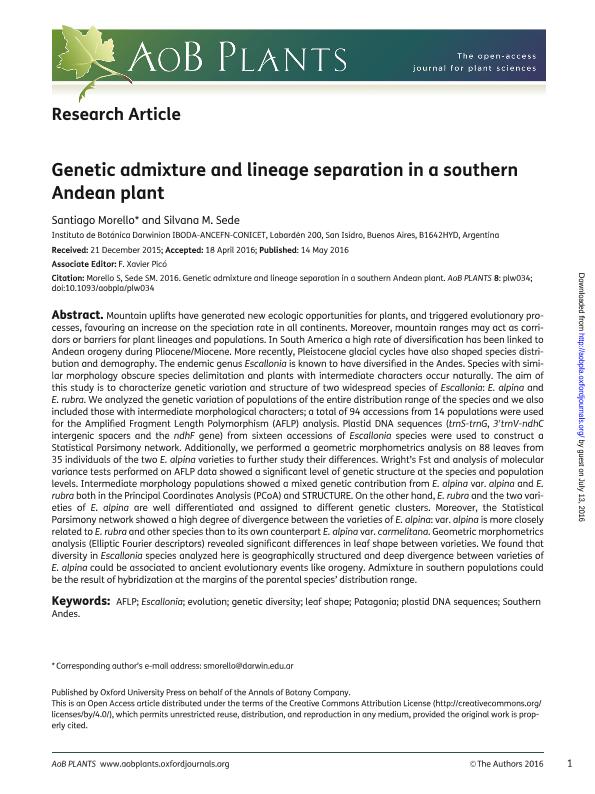Mostrar el registro sencillo del ítem
dc.contributor.author
Morello, Santiago

dc.contributor.author
Sede, Silvana Mabel

dc.date.available
2017-07-06T18:34:14Z
dc.date.issued
2016-07
dc.identifier.citation
Morello, Santiago; Sede, Silvana Mabel; Genetic admixture and lineage separation in a southern Andean plant; Oxford University Press; AoB Plants; 8; plw34; 7-2016; 1-14
dc.identifier.uri
http://hdl.handle.net/11336/19760
dc.description.abstract
Mountain uplifts have generated new ecologic opportunities for plants, and triggered evolutionary processes, favouring an increase on the speciation rate in all continents. Moreover, mountain ranges may act as corridors or barriers for plant lineages and populations. In South America a high rate of diversification has been linked to Andean orogeny during Pliocene/Miocene. More recently, Pleistocene glacial cycles have also shaped species distribution and demography. The endemic genus Escallonia is known to have diversified in the Andes. Species with similar morphology obscure species delimitation and plants with intermediate characters occur naturally. The aim of this study is to characterize genetic variation and structure of two widespread species of Escallonia : E. alpina and E. rubra . We analyzed the genetic variation of populations of the entire distribution range of the species and we also included those with intermediate morphological characters; a total of 94 accessions from 14 populations were used for the Amplified Fragment Length Polymorphism (AFLP) analysis. Plastid DNA sequences ( trnS-trnG , 3 ′ trnV-ndhC intergenic spacers and the ndhF gene) from sixteen accessions of Escallonia species were used to construct a Statistical Parsimony network. Additionally, we performed a geometric morphometrics analysis on 88 leaves from 35 individuals of the two E. alpina varieties to further study their differences. Wright’s Fst and analysis of molecular variance tests performed on AFLP data showed a significant level of genetic structure at the species and population levels. Intermediate morphology populations showed a mixed genetic contribution from E. alpina var. alpina and E. rubra both in the Principal Coordinates Analysis (PCoA) and STRUCTURE. On the other hand, E. rubra and the two varieties of E. alpina are well differentiated and assigned to different genetic clusters. Moreover, the Statistical Parsimony network showed a high degree of divergence between the varieties of E. alpina : var. alpina is more closely related to E. rubra and other species than to its own counterpart E. alpina var. carmelitana . Geometric morphometrics analysis (Elliptic Fourier descriptors) revealed significant differences in leaf shape between varieties. We found that diversity in Escallonia species analyzed here is geographically structured and deep divergence between varieties of E. alpina could be associated to ancient evolutionary events like orogeny. Admixture in southern populations could be the result of hybridization at the margins of the parental species’ distribution range.
dc.format
application/pdf
dc.language.iso
eng
dc.publisher
Oxford University Press

dc.rights
info:eu-repo/semantics/openAccess
dc.rights.uri
https://creativecommons.org/licenses/by-nc-sa/2.5/ar/
dc.subject
Aflp
dc.subject
Escallonia
dc.subject
Evolution
dc.subject
Genetic Diversity
dc.subject
Leaf Shape
dc.subject
Patagonia
dc.subject
Plastid Dna Segueces
dc.subject
Southern Andes
dc.subject.classification
Ciencias de las Plantas, Botánica

dc.subject.classification
Ciencias Biológicas

dc.subject.classification
CIENCIAS NATURALES Y EXACTAS

dc.title
Genetic admixture and lineage separation in a southern Andean plant
dc.type
info:eu-repo/semantics/article
dc.type
info:ar-repo/semantics/artículo
dc.type
info:eu-repo/semantics/publishedVersion
dc.date.updated
2017-07-05T18:15:35Z
dc.identifier.eissn
2041-2851
dc.journal.volume
8
dc.journal.number
plw34
dc.journal.pagination
1-14
dc.journal.pais
Reino Unido

dc.journal.ciudad
Oxford
dc.description.fil
Fil: Morello, Santiago. Consejo Nacional de Investigaciones Científicas y Técnicas. Instituto de Botánica Darwinion. Academia Nacional de Ciencias Exactas, Físicas y Naturales. Instituto de Botánica Darwinion; Argentina
dc.description.fil
Fil: Sede, Silvana Mabel. Consejo Nacional de Investigaciones Científicas y Técnicas. Instituto de Botánica Darwinion. Academia Nacional de Ciencias Exactas, Físicas y Naturales. Instituto de Botánica Darwinion; Argentina
dc.journal.title
AoB Plants
dc.relation.alternativeid
info:eu-repo/semantics/altIdentifier/doi/http://dx.doi.org/10.1093/aobpla/plw034
dc.relation.alternativeid
info:eu-repo/semantics/altIdentifier/url/https://academic.oup.com/aobpla/article-lookup/doi/10.1093/aobpla/plw034
dc.relation.alternativeid
info:eu-repo/semantics/altIdentifier/url/https://www.ncbi.nlm.nih.gov/pmc/articles/PMC4940511/
Archivos asociados
